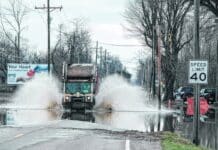Certain kinds of emergencies don’t enter our awareness until they happen: Cattle stranded by floodwaters, a farmer trapped in a grain bin, a transport truck full of animals overturns on the interstate. Agriculture can be dangerous business, both on and off the farm.
Sure enough, the U.S. Department of Labor’s Bureau of Labor Statistics lists farm occupations as the No. 2 most dangerous, as measured by fatalities.
Lately we have been planning some programming around conditions where emergency services and agriculture might meet, which is often in unfortunate circumstances. Training and awareness can help to manage some of the risk that comes with agricultural territory, both in prevention and when things start to go wrong. From grain bin and tractor safety to electrical awareness and farmstead layout, Purdue Extension offers many resources intended to foster safety in agricultural operations.
Covering the space from prevention to disaster, the Extension Disaster Education Network (ag.purdue.edu/extension/eden/Pages/default.aspx) provides resources for a range of natural and unnatural disasters on and off of the farm.
Then there is training specifically for emergency responders who might need to train in grain bin rescue or dealing with loose livestock in an emergency. On the grain bin front, a training for emergency responders is planned for May 21, when professor Bill Field will provide instruction on mounting a rescue.
In September 2014, local emergency responders and animal control personnel had a chance to learn and practice techniques for dealing with loose livestock. As someone with zero livestock background, I can say that there is much to know. Emergency responders who have practiced, and know how and where to get help at odd hours, can save human lives and animal suffering.
Find corral materials at 2 a.m.? Know what and what not to do near a spooked horse? When not to use sirens? Loose pigs on the interstate? These are only a few examples of some of the events for which our emergency management folks must try to prepare.
Programming, such as the event conducted in 2014, is usually a joint effort between the State Board of Animal Health, FEMA, Homeland Security, Extension and local agencies. Shared understanding of best practices and emergency protocols, as well as practice, help to make those emergency responses more effective.
Tree felling is another agricultural activity where things can go terribly wrong. Look for a workshop on chainsaw safety and tree felling to be offered here in Bartholomew County in the fall. This learning event will be for woodland owners who expect to be felling trees for timber stand improvement or harvest going into the winter.
As with so many other things that happen only occasionally, I am ever grateful for individuals who devote their life’s work to understanding and managing some event that happens only rarely, especially when lives are at stake.




